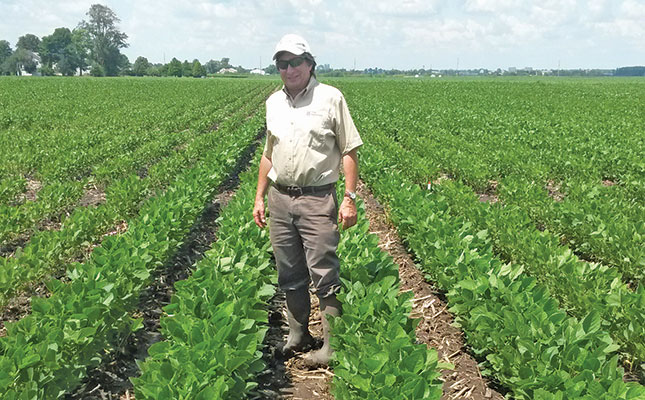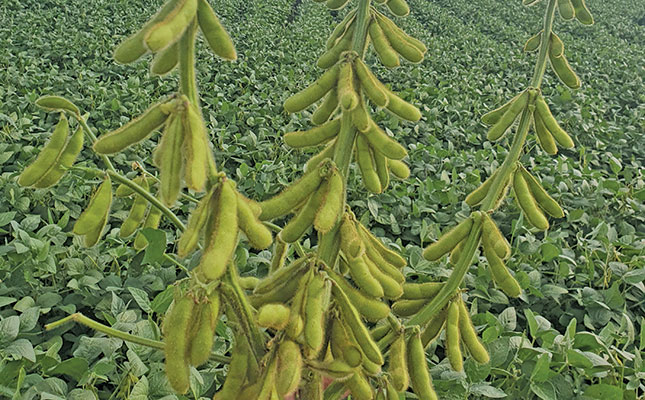A healthy plant will flower, bear fruit and seeds, and reproduce; an unhealthy plant will always struggle to do so. The secret to successful soya bean production lies in keeping your plants healthy from planting right through to harvesting.
To do this, proper planning and good cultivation management are critical to ensuring that you harvest every possible kilogram per hectare.
To achieve this, it’s crucial to visit the lands and scout the plants for diseases and pests, says Andries Wessels, manager of product development at Syngenta.
“Nothing can make up for knowledge. By visiting lands frequently, you can identify problems timeously and address them before they escalate into a disaster.
“In addition, look for the cultivar that’s best suited to your particular area, using multi-year trial data. That’s always a safe choice: [a combination of] your own experience, trial data from your area and trial data supplied by the Agricultural Research Council, companies and study groups will provide useful information to base your choices on.”
Ensuring a good yield
To maximise yield, farmers are advised to adopt a systems-based approach to planting. Such a comprehensive agronomic management programme includes a combination of cultivation practices, cultivar choice, and the use of herbicide, fungicide and insecticide.
Prof Fred Below, a specialist in plant physiology in the Department of Crop Sciences at the University of Illinois in the US, describes six ‘secrets’ in soya bean production that are critical for achieving optimal yield.

These are mitigating the effects of poor weather conditions, improving soil fertility, genetics, foliar protection, seed treatment, and row spacing.
According to him, these factors demonstrate how farmers can combine technologies to increase soya bean yield through intensive crop management. He often stresses that adding one more pod to each soya bean plant will increase the total yield significantly.
“These six aspects are not really secrets, but represent those management factors that can impact yield each year,” says Below. “There are, however, crucial prerequisites in soya bean production that are needed before a farmer can take advantage of the six secrets. These prerequisites include proper drainage, a strong weed management programme, and appropriate soil pH levels. Once the prerequisites are satisfied, good fertilisation, combined with foliar protection, leads to yield increases, regardless of the variety.”
The six ‘secrets’
Aspects of Below’s sixfold management approach are borne out by experience here in South Africa, and contain valuable lessons for local growers of the crop.
Mitigate the effects of poor weather conditions
According to Below, management practices that promote strong root development, such as excellent-quality seed, fertilisation, enhanced seed emergence, and disease control, may help mitigate many of the weather’s negative effects. To Danie Bester, who farms on Rietbult Estates near Balfour in Mpumalanga, the planting date is one of the most important aspects of soya bean production. He emphasises the value of planting early in the season.
“I normally plant soya bean in mid-October, before maize. I’m now building another planter so that we can plant soya bean and maize early in the season, when conditions are optimal. I’ve seen first-hand on my farm that this is the best approach. A land that we planted on 12 October produced an average of 202 pods/ plant, while one planted almost a month later produced only 65 pods/plant. Planting earlier ensures more sunlight, which gives more time for flowering and therefore more pods,” says Bester.
Improving soil fertility and nutrition
Below says that although soil fertility is one of the most crucial factors, it is often overlooked. It can be improved, however, through balanced crop nutrition and fertiliser placement technologies.
“Because soya bean is a protein crop, it requires a great deal of nitrogen. For decades we’ve relied on the plant’s ability as a legume to fix its own nitrogen. [But] soya bean gets only about 50% of the nitrogen it needs from the nodules, with the rest coming from the soil. As yields increase, nitrogen becomes increasingly limited.”
Below says that farmers may need to consider treating their seed with a better bacterial Rhizobium inoculant, or add some nitrogen as fertiliser. He adds that phosphorus and sulphur can also have a significant effect on yield and should be kept in mind as fertiliser components.
According to Wessels, the fertiliser programme should be determined by the field’s yield potential in combination with the cultivar’s requirements.
“Taking soil and foliar samples is crucial to determine which macro- and microelements should be applied throughout the season.”
He also cautions that although soya bean can fix its own nitrogen, the lack of other essential elements can have a detrimental effect on the overall yield at the end of the season.
Bester believes that good farming practice begins with proper soil management. “The biology behind soil is extremely important. If you don’t have fertile soils, you won’t realise good yields. After correcting the soil fertility, you can move to the next step, which is to look at the specific cultivar or hybrid.”
He cautions that fertilisation and cultivar selection are closely linked, and points out that potassium is the biggest driver of yield.
“Because improved genetics have more potential, they need more nutrients to sustain that potential.
“The biggest game changer for me was starting to do zone fertilisation. Multi-year yield data layered onto soil type data created management zones for fertilisation, and that eliminated the over- and under-fertilisation of different yield potential zones. Every zone receives the correct amount of fertiliser. Soil acidity levels are stabilised and consequently the yield per zone has increased significantly.
“Calcium is also especially important for the beans to maintain their moisture. The only way to do this is to ensure that your lime applications are done correctly at the start of the season and that the pH is correct.
“You can buy the best planter and use state-of-the-art precision planting technology, but if your soil isn’t fertile, these will be of no use. One can take an old planter and plant in fertile soil and still realise a decent crop on that field. Only by combining good soil and fertilisation programmes with technology can one realise optimum yields.”
Cultivar selection
According to Below, the proper selection of soya bean varieties is crucial for success in a high-yield, management-intensive production system. Seed variety has a definite influence on yield, and the variety that achieves the fullest maturity for the region tends to lead to the largest yield increases. There are numerous aspects that influence cultivar selection.
– Grow length is one of the critical aspects in choosing a cultivar. Soya beans are sensitive to daylight, and the further south they are planted, the later they will mature.
Temperatures, especially night temperatures, influence the growth of the plants. This is why soya beans in the eastern production areas grow at a slower rate than those in the warmer western parts of the country. It is generally accepted that cultivars with a longer growth season perform better in the western areas with a warmer climate, medium-growth season cultivars do well in more moderate temperatures, and short growers perform better in areas with a cooler climate.
– The optimal planting date in a specific area will influence the cultivar choice as it will determine the choice between an early- or late-maturity variety. The best planting date is from mid-October, but in the warmer areas, farmers can still plant until December. According to Bester, soya beans should be planted before or at the same time as maize.
– Plant and pod height will have an influence on the standability as well as harvestability of the variety. Relatively short-growing season cultivars very often have shorter plants with pods lower on the plant.
– Production practices will have an impact on many of the soya bean plant’s attributes.
Narrow rows and narrower spaces between the plants in the row can result in pods
higher up on the plant. Varieties that are prone to making side shoots will be more suitable for wider rows, while those with fewer side shoots and a more open canopy are more suited to narrower rows.
– Standability can be determined by the number of overcast days during a season. Long spells of overcast days can cause plants to grow higher and create standability issues.
– Cultivars with a determined growth should ideally be planted under irrigation, while indeterminate cultivars that do not stop growing when flowering are more suitable for dryland conditions.
Crop protection
“Disease and insect control is imperative to protect yield potential. By using a combination of a fungicide and insecticide, critical soya bean leaf area is maintained for intercepting sunlight and maximising seed fill,” says Below.
Soya beans are sensitive to the use of certain herbicides, such as atrazine. It is critical to follow the directions on the labels carefully and adhere to the waiting periods to prevent herbicide damage.
Seed treatment
This can help maximise the growth potential of the plants. Using fungicidal, insecticidal and plant-growth regulator seed treatments on young emerging seedlings will protect them from yield-robbing stresses such as disease and insects.
Row spacing
Below believes there are distinct advantages to planting narrow rows, and that sunlight that strikes the ground instead of green leaves in wide rows represents lost yield. The benefit of narrower rows is amplified when other yield-boosting practices are incorporated into a production system.
When planted at a reduced seeding rate, narrow rows allow for more space between plants within a row and increased branching. The planting of narrower rows is one management aspect that can increase yield drastically.
Narrower rows will allow precision fertiliser placement in a rotation of maize and soya bean. Planting soya beans on these same rows might take advantage of the previous year’s maize fertility practices. Furthermore, the plants form a canopy much quicker, and narrower rows improve light interception and ultimately provide a good foundation for maximising yields, says Below.
Plant density will be determined by the cultivar, the production area, the climate, the soil type, cultivation practices and row width. Planting practices are also important aspects in soya bean production.
The deeper the seed is planted, the thinner the seedling will be as it stretches to emerge above soil level. This makes the seedling extremely vulnerable to damage early in the season. The correct plant depth is therefore important, says Wessels.
Bester says that knowledge is important for profitable farming, and it is thus crucial to gather information on your farm.
“The more data one gathers, the better the overall picture of what is going on in your farming enterprise will be. This is especially true for soya bean farming,” he advises.



